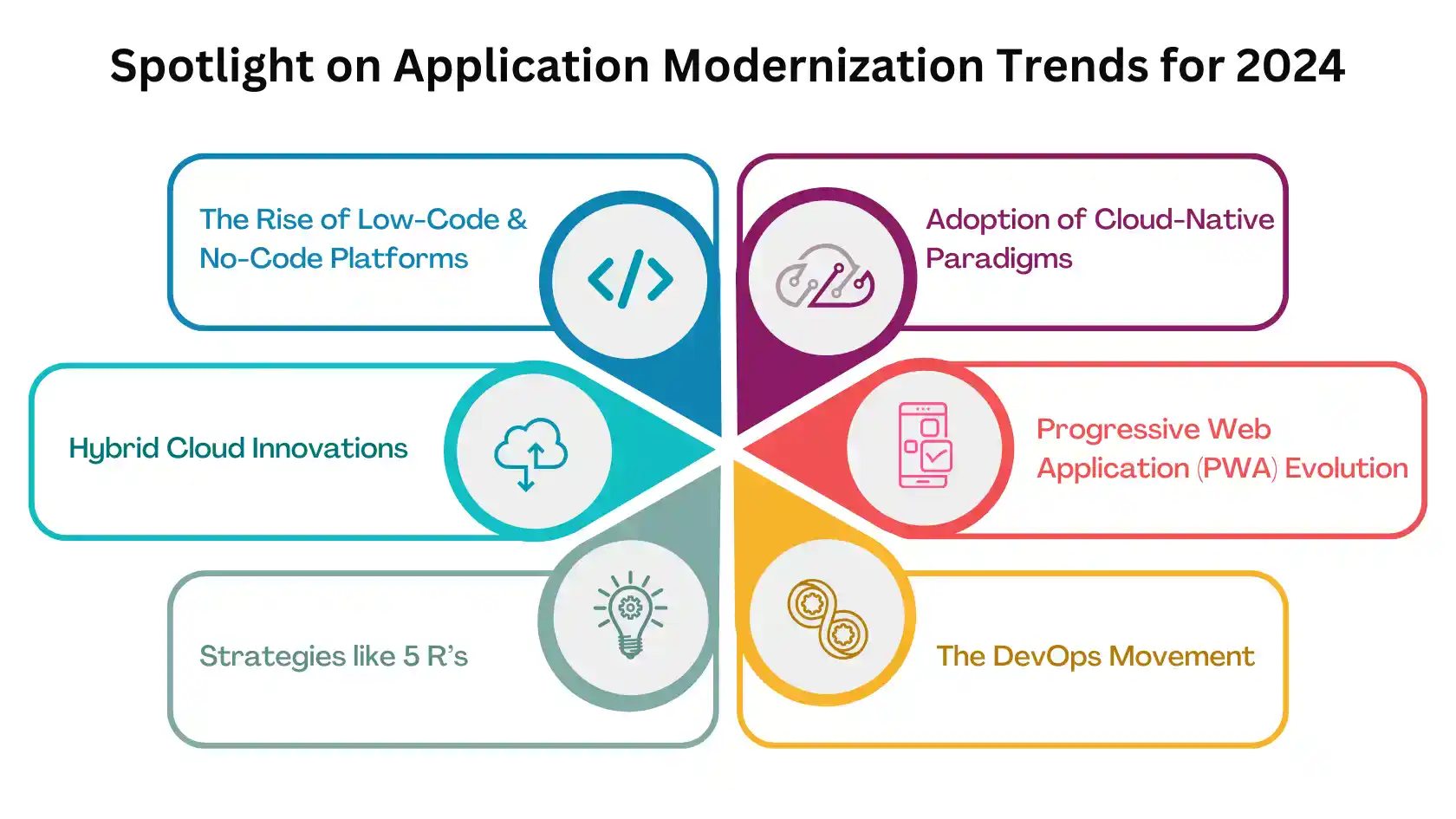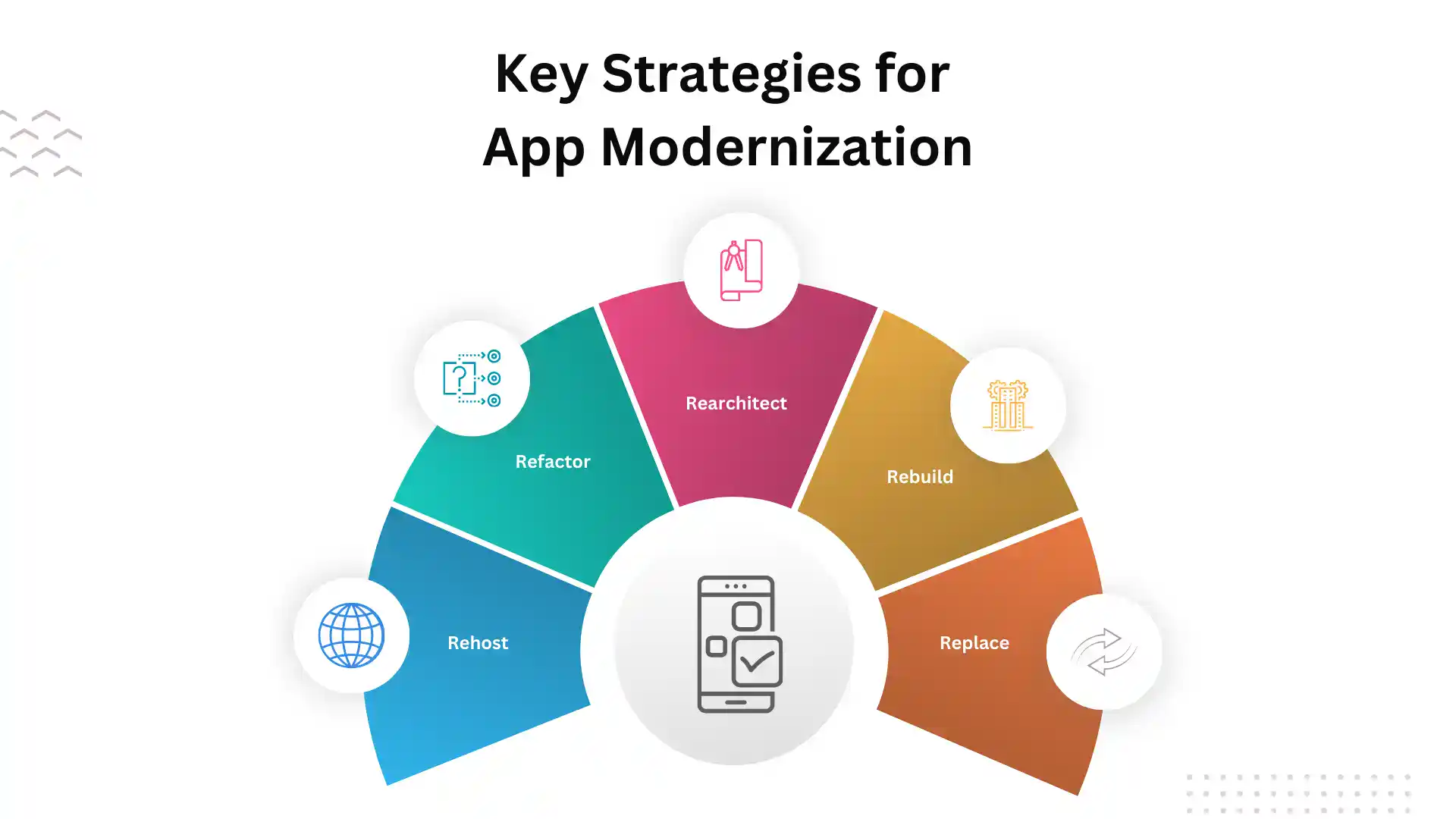Table of Contents
Understanding Application Modernization
In the fast-paced world of technology, application modernization stands out as a beacon of continuous evolution and growth. It represents the proactive approach of businesses in refining and upgrading their existing software tools, ensuring that they keep pace with the fluid demands of the digital sphere. As technology progresses at an unprecedented rate, a significant number of organizations are facing the challenge of outdated legacy systems. Such systems, while once the backbone of their operations, now act as barriers, curtailing innovation, flexibility, and overall operational effectiveness.
At the heart of application modernization lies the mission to rejuvenate these mature applications, equipping them with the capabilities of today’s state-of-the-art technologies and innovative methodologies. The essence of this transformation is not just about replacing old with new; it’s about harnessing the power of modern technological advancements to optimize business processes. Companies venturing into this transformational journey unlock a plethora of benefits. These range from achieving scalable solutions that can adapt to changing business needs, bolstering security to protect against contemporary threats, to enhancing the overall user experience, making interactions more intuitive and user-friendly. Moreover, modernized applications can be maintained more efficiently, ensuring they remain robust and reliable.
The pursuit of application modernization is a testament to a company’s commitment to staying relevant and competitive. By refreshing their software landscape, businesses are not merely updating their tools; they are setting the stage for sustainable growth, agility, and innovation. This proactive approach enables them to anticipate and address challenges, adapt to market shifts, and seize new opportunities, ensuring they remain leaders in a digitally driven market.
Looking ahead to 2024, the landscape of application modernization is set to witness some groundbreaking trends. As we delve deeper into this article, we will uncover the top emerging patterns and methodologies that companies should be cognizant of. Understanding and embracing these trends will be crucial for businesses aiming to fortify their digital presence and continue to thrive in an increasingly interconnected global economy.
Spotlight on Application Modernization Trends for 2024

The Rise of Low-Code & No-Code Platforms
Low-code/no-code platforms like kissflow are becoming game-changers. Offering intuitive visual interfaces coupled with drag-and-drop features and modular components, these platforms expedite the app modernization process, demanding minimal coding expertise.
Adoption of Cloud-Native Paradigms
The cloud-native mantra is steadfastly marking its presence in the modernization sphere. Utilizing the might of cloud solutions, container ecosystems, and orchestration tools, enterprises can experience unmatched scalability, adaptability, and robustness – hallmark features of seamless app modernization in a cloud-centric ecosystem.
Hybrid Cloud Innovations
For organizations that prioritize security, hybrid cloud emerges as a beacon. Melding the capabilities of the public cloud with the assurances of private servers and clouds, hybrid clouds employ advanced methodologies such as edge computing. Edge computing, for instance, can locally process data for applications that demand higher security, safeguarding against potential cyber threats.
Progressive Web Application (PWA) Evolution
PWAs, architected to amplify the mobile web domain, are crafted to furnish a user experience that mirrors native applications. By leveraging technologies like Manifest and Service Worker, PWAs offer rapid load times and data efficiency. With their adaptive nature, PWAs ensure a harmonious experience across diverse devices, as evidenced by global giants like Uber and Starbucks adopting this technology.
Strategies like Replatforming, Refactoring, and Repurchasing
In the realm of cloud migration and app modernization, tactics such as Replatforming, Refactoring, and Repurchasing are gaining traction. While Replatforming updates core components without tweaking the fundamental code, Refactoring involves a more profound transformation using tools like Kubernetes.
The DevOps Movement
DevOps emerges as a linchpin in the legacy application rejuvenation journey. With its emphasis on team synergy, automation, and process optimization, DevOps enhances software quality and reliability. By incorporating emerging technologies and best practices, DevOps amplifies the entire app modernization initiative.
In essence, 2024 seems poised to witness app modernization trends like low-code/no-code platforms, cloud-native innovations, and the DevOps revolution, to propel toward digital transformation.
Application Modernization Blueprint: A Journey in Three Steps

Strategic Planning
Before diving deep, organizations need to map out their modernization objectives. This preliminary phase involves a comprehensive analysis of the existing app landscape, pinpointing areas ripe for innovation and establishing a clear roadmap for transformation.
Agile Execution
Instead of an overwhelming overhaul, the modernization process is best approached in agile sprints. This iterative strategy not only facilitates flexibility but also ensures that adjustments can be made in real-time, aligning with evolving business goals or technological shifts.
Sustained Operations
Transitioning to a cloud-centric framework is just the beginning. In this final phase, the emphasis shifts to leveraging the vast array of cloud tools and services. These invaluable resources aid in securing, governing, and refining apps, ensuring they remain robust, efficient, and aligned with business objectives.
Key Strategies for App Modernization

Often referred to as R’s of app modernization strategy. Here are the strategies that is followed industry-wide:
- Rehost: Termed as the ‘lift and shift’ approach, Rehosting is about transferring an application’s resources to a cloud setting without code modifications. Although simple, this technique may not leverage cloud-native features to the fullest.
- Refactor: Maintaining most of the original code, Refactoring transitions applications to cloud infrastructure. This method has the potential to give an illusion of modernity without fully embracing the cloud’s strengths.
- Rearchitect: This approach involves segmenting a monolithic application into modular services. It’s a strategic move that brings agility, reduces costs, and allows for rapid innovation.
- Rebuild: Here, the application undergoes a complete overhaul, making it cloud-native. This can fast-track innovation and operational efficiency.
- Replace: If an old application retains some usable functions, it can be substituted with a more agile cloud solution, transitioning from a licensed model to a subscription-based one.
The Edge of App Modernization
There are certain advantages of app modernization, such as:
- Elevated Efficiency: Streamlined operations and reduced inefficiencies.
- Boosted Scalability: Align software infrastructures with evolving demands.
- Refined User Experience: Offer intuitive interfaces with rapid response times.
- Cost Efficiency: Reduce support costs and resource wastage.
- Robust Security: Mitigate vulnerabilities and stay compliant.
Embracing app modernization is more than just a technological shift; it’s about securing a competitive edge and ensuring future readiness in an increasingly digital landscape. If you’re ready to elevate your organization’s digital capabilities and unlock unparalleled benefits, it’s time to embark on the modernization journey. Connect with our team of experts today and let us guide you through each step, turning your app modernization aspirations into tangible results.
FAQ
What is application modernization?
Application modernization involves updating legacy software to meet current technological standards and business needs, often integrating new languages, platforms, and cloud services. This process boosts efficiency, enhances user experience, and maintains software relevance in a dynamic digital world.
What are the 5 Rs of application modernization?
The 5 R’s of application modernization represent a structured approach to updating and transforming legacy software systems to meet current business and technological needs. They are:
- Rehost: This involves moving an application from its current environment to a new one, typically a cloud platform, without making significant changes to its architecture. It’s often referred to as a “lift-and-shift” approach.
- Refactor: In this approach, some portions of the existing application are restructured to take advantage of newer capabilities, often while retaining its core purpose and functionality. It’s like renovating certain parts of a house while keeping the overall structure intact.
- Rearchitect: This strategy entails redesigning the application’s underlying architecture to align better with modern best practices, such as transitioning from a monolithic design to a microservices architecture.
- Rebuild: This is a more radical approach where the application is redeveloped from scratch using modern technologies and methodologies, ensuring it’s built to current standards.
- Replace: Here, instead of updating the existing application, it’s entirely replaced with a new solution, often a commercial off-the-shelf software that meets the organization’s needs.
By understanding and leveraging these strategies, businesses can make informed decisions on the best way to modernize their legacy systems effectively.
What is the importance of app modernization?
Application modernization is crucial for businesses to remain competitive, enhancing operational efficiency, user engagement, and security. By updating software, organizations foster innovation and agility, ensuring resilience and long-term growth in the evolving digital landscape.
What are the challenges of application modernization?
Modernizing applications comes with its set of challenges. These can include technical debt, legacy system integration, resistance to change within the organization, skill gaps in modern technologies, and potential business disruptions during the transition.
How does application modernization differ from digital transformation?
While both terms are related, application modernization focuses on updating and optimizing existing software applications. In contrast, digital transformation is a broader initiative that encompasses not only technological changes but also shifts in business processes, culture, and customer experiences to leverage digital capabilities fully.
What tools and technologies are commonly used in application modernization?
There are a plethora of tools and technologies used in the modernization process. Some popular ones include cloud platforms (like AWS, Azure, and Google Cloud), containerization tools (like Docker and Kubernetes), microservices architectures, and DevOps tools (like Jenkins, Terraform, and Ansible).
How long does the application modernization process typically take?
The duration of the modernization process can vary widely based on the complexity of the existing application, the chosen modernization strategy, organizational readiness, and the scope of changes. It can range from a few weeks for simple rehosting projects to several months or even years for comprehensive rebuilds or rearchitecture efforts.
Is application modernization cost-effective?
While there are initial costs associated with modernizing an application, the long-term benefits often justify the investment. Modernized applications can lead to reduced maintenance costs, better performance, increased agility, and the ability to leverage new technologies and innovations. Moreover, not modernizing can result in higher costs in the future due to increased technical debt and potential system failures.